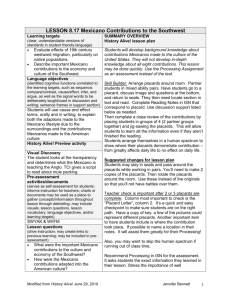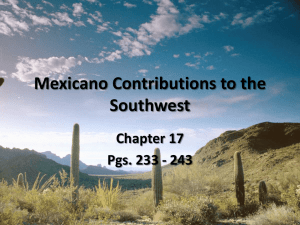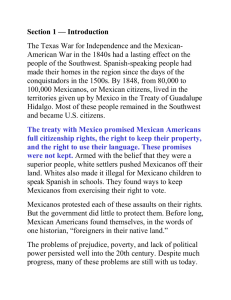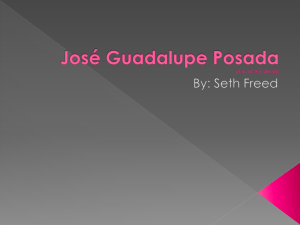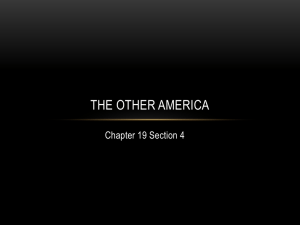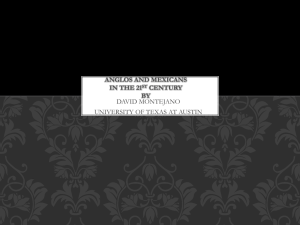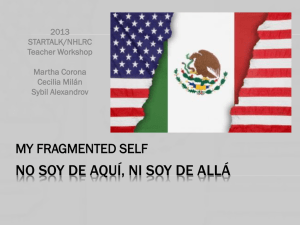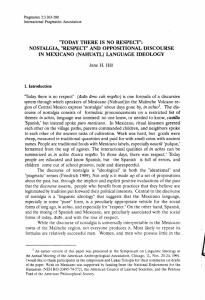Ch. 17: Mexicano Contributions to the Southwest
advertisement
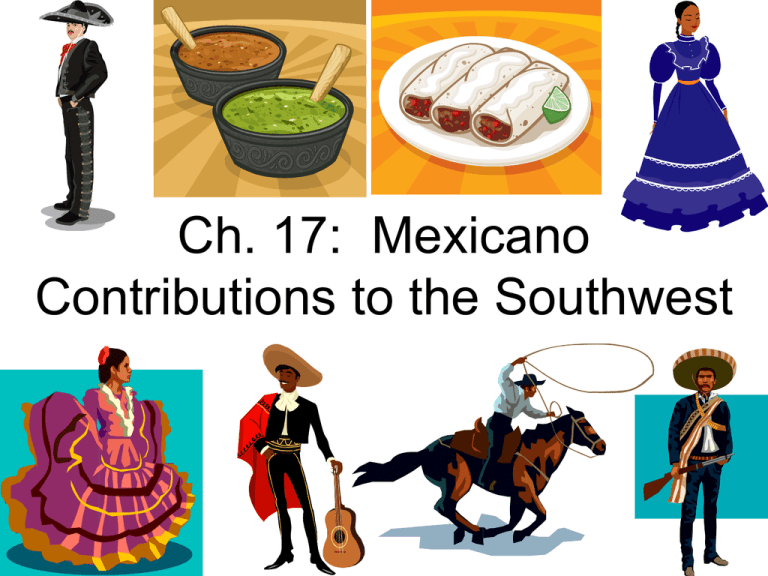
Ch. 17: Mexicano Contributions to the Southwest What is a Mexicano Contribution? • As you learned in Ch. 15, Texas gained its independence from Mexico in 1836 and was annexed by the U.S., becoming a state in 1845. The U.S. then fought and won a war against Mexico in 1848, gained much of what is know as the southwestern part of the U.S. (California, Nevada, Utah, New Mexico, and Arizona). What is a Mexicano Contribution? • Spanish-speaking people had made their homes in this region since the 1500s. • There were 80,000 to 100,000 Mexicanos, or Mexican citizens, living in the territories given up by Mexico in the Treaty of Guadalupe in 1848. • Most of these people remained in the Southwest and became citizens of the U.S. • Their experience in this rugged environment would greatly contribute to the prosperity of the American settlers moving in. • This chapter discusses these areas of Mexicano contribution. This picture of a Mexicano helping an American settler pack a mule illustrates how Americans moving out west benefited from the Mexicanos’ knowledge and experience. Lets Look at the Nine Mexicano Contributions Discussed in Ch. 17 • • • • • • • • • 17.2: Mexicano Mining Contributions (pg. 230) 17.3: Cattle Ranching (pg. 231) 17.4: The Cowboy (pg. 232) 17.5: Sheep Raising (pg. 233) 17.6: Irrigated Farming (pg. 234) 17.7: Mexican Food (pg. 235) 17.8: Spanish-style Architecture (pg. 236) 17.9: Mexican Laws (pg. 237) 17.10: Mexicano Entertainments (pg. 238) 17.2: Mexicano Mining Contribution • Americans knew nothing about mining techniques, or about quartz, silver, and copper mining. • Mexicanos taught American miners how to use the batea, riffle box, and Batea arrastra to (gold pan) mine. 17.2: Mexicano Mining Contribution Arrastra (grinding mill) Riffle box (the heavy gold was trapped behind the riffles) 17.2: Mexicano Mining Contribution A Closer Look at the Riffle Box: Dirt is placed at the top and water is poured over it, washing away everything but the gold. The gold, being heavy, gets stuck behind the riffles (the little rectangle pieces of wood). Arrastra (grinding mill) 17.2: Mexicano Mining Contribution • Mexicanos were also responsible for discovering the two precious metals of silver and copper in the West. • Silver was mined mostly in Nevada, while copper was mined mostly in Arizona. 17.3: Cattle Ranching • Branding is the burning of a rancher’s mark (symbol) onto his cattle to identify it as belonging to him. • The branding was done by his hired cowboys (as you can see in the picture to the right). 17.3: Cattle Ranching • Cowboys would tie down cattle, then place the end of the hot iron in a fire until it turned a bright orange. Then, they would place it against the hide of the cattle. • Branding was necessary because herds belonging to different owners often mixed together on unfenced grasslands. 17.3: Cattle Ranching • Before branding the cattle, they first had to be rounded up, called a rodeo. • Today’s professional sport of rodeo has it’s roots in the cattle roundups on Mexicano ranchos (ranches). 17.4: The Cowboy A vaquero is a Mexicano cowboy. 17.5: Sheep Raising • Sheep raising was a big, well-organized business for the Mexicanos. • Americans moving to the Southwest quickly adopted this large scale system of producing wool. 17.5: Sheep Raising • One particular type of sheep, the churro was used throughout the Southwest rather than other forms of sheep because it knew how to survive in a dry environment like that of the Southwest. 17.6: Irrigated Farming • Irrigation is the process of supplying dry land with water, often through ditches (like those you see in this picture). • Irrigation was necessary to farming in the West, because many areas of the Southwest had dry environments where months could go by with no rain. In other words, there wasn’t enough water without irrigation. 17.6: Irrigated Farming • In the Mexican system of irrigation, a field is divided into squares marked off by a wall of earth high enough to hold in water. • When one square has been soaked with water, a hole is made in the wall so water can flow into the next square. • This process is repeated until the entire field is soaked. 17.6: Irrigated Farming • Irrigation allowed for many foods to be farmed that hadn’t been farmed by Americans previously, including many citrus fruits. • This included grapes, dates, olives, apples, walnuts, pears, plums, peaches, apricots, quinces, lemons, limes, and oranges. 17.7: Mexican Food • The mostly widely recognized Mexicano contribution is Mexican food. • But what many Americans view as Mexican food is really “Tex-Mex.” • “Tex-Mex” is the blending of Mexican and American dishes. 17.7: Mexican Food • The food you get at Taco Bell is a good example of “Tex-Mex” cooking. 17.8: Spanish-style Architecture Spanish-style architecture consists of courtyards, rounded arches, thick adobe walls, and red tile roofs. 17.8: Spanish-style Architecture • Since there weren’t a lot of trees in the Southwest, Mexicanos used adobe bricks as their main building materials. • Adobe is a mixture of earth, grass, and water that is shaped into bricks and baked in the sun. • Many homes in the Southwest today are made using of adobe. 17.9: Mexican Laws • Mining Law- Before the discovery of gold in California, there was so little mining in the U.S. that there was no mining law. But with the gold rush in California, it quickly became clear that the forty-niners needed rules in order to keep order. • As a result, Americans developed a “law of the mines” based on Mexican mining law, which helped keep order. 17.9: Mexican Laws • Community Property Law- In the eastern states, married women had few property rights and any property acquired by a married couple—such as a home, farm, or business— belonged solely to the husband. • In contrast, Mexican law said that all property acquired during a marriage was “community property.” If a couple separated, half of the property belonged to the wife and half to the husband. This greatly benefited women. 17.9: Mexican Laws • Water Law- Under Mexicano water law, known as “pueblo law,” water is seen as too valuable to be owned or controlled by any one person. Instead, water is considered to belong to the entire community and should be used for the benefit of all (shared). 17.10: Mexicano Entertainments • Mexicanos worked hard, but they also knew how to entertain themselves with music, dance, and fiestas (celebrations, parties). 17.10: Mexicano Entertainments • Mexicano music greatly influenced country and western music in the Southwest. • The most important contribution was the corrido, or folk ballad. • A corrido is a dramatic story sung as a guitar is played. 17.10: Mexicano Entertainments • The most widely celebrated Mexicano holiday is El Cinco de Mayo (the Fifth of May). • It is similar to the Fourth of July for Americans. • It commemorates an important victory in Mexico’s fight for independence from French rule in 1862. • Today, Cinco de Mayo fiestas bring together Mexican and non-Mexican Americans to Mexicano music, dance, and food.
